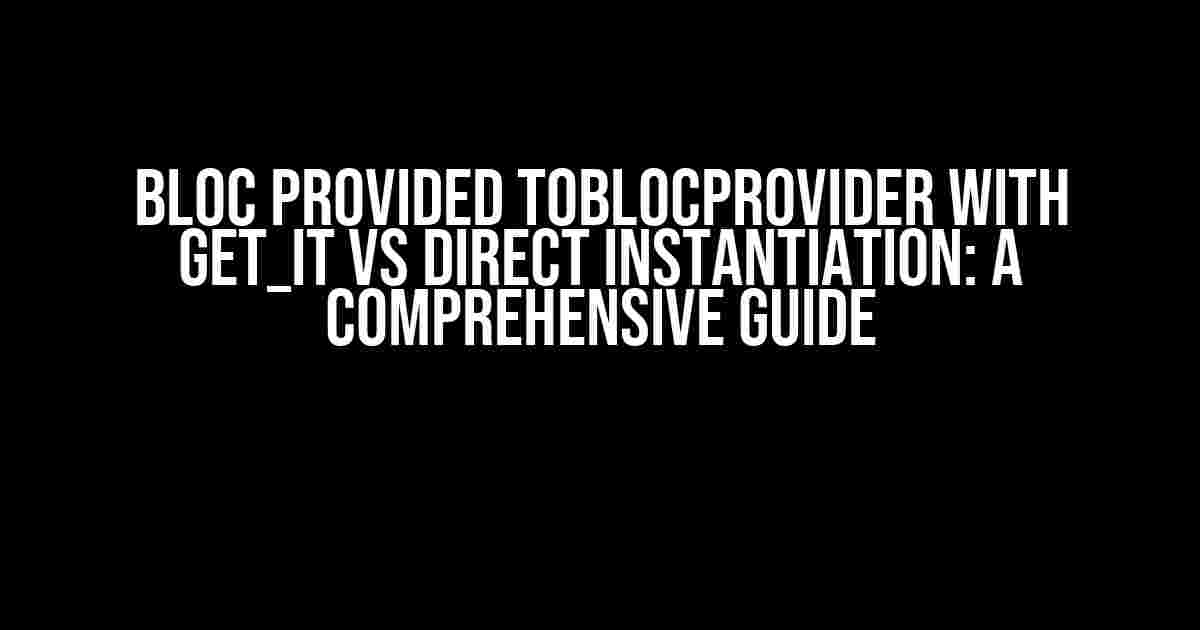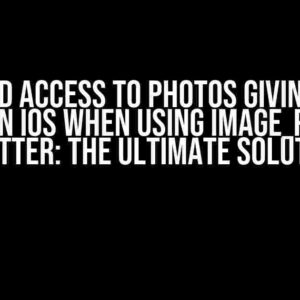In the world of Flutter, Blocs and Providers are two popular architectural patterns used to manage app state and inject dependencies. When it comes to providing a Bloc to a BlocProvider, developers often wonder whether to use get_it or direct instantiation. In this article, we’ll dive into the differences between these two approaches, exploring the pros and cons of each, and provide a clear guide on how to implement them.
What is get_it?
get_it is a popular Flutter package for service location and dependency injection. It provides a simple and efficient way to register and retrieve instances of your app’s services, including Blocs. get_it is often used to decouple dependencies between widgets and services, making it easier to test and maintain your app.
How to use get_it with BlocProvider
To use get_it with BlocProvider, you need to register your Bloc instance with get_it and then retrieve it in your BlocProvider. Here’s an example:
// Register Bloc instance with get_it
GetIt getIt = GetIt.instance;
getIt.registerSingleton<MyBloc>(MyBloc());
// Use BlocProvider with get_it
MultiBlocProvider(
providers: [
BlocProvider<MyBloc>(
create: (_) => getIt<MyBloc>(),
),
],
child: MyApp(),
)
Direct Instantiation
Direct instantiation involves creating an instance of your Bloc directly in your BlocProvider. This approach is straightforward and easy to implement, but it has its own set of limitations.
How to use direct instantiation with BlocProvider
To use direct instantiation with BlocProvider, you simply create an instance of your Bloc and pass it to the BlocProvider:
// Use BlocProvider with direct instantiation
MultiBlocProvider(
providers: [
BlocProvider<MyBloc>(
create: (_) => MyBloc(),
),
],
child: MyApp(),
)
Pros and Cons of each approach
In this section, we’ll discuss the advantages and disadvantages of using get_it and direct instantiation with BlocProvider.
get_it approach
| Pros | Cons |
|---|---|
|
|
Direct Instantiation approach
| Pros | Cons |
|---|---|
|
|
When to use each approach
In this section, we’ll provide guidance on when to use get_it and when to use direct instantiation with BlocProvider.
Use get_it when:
- You need to decouple dependencies between widgets and services
- You want to make testing and mocking easier
- You have a large, complex app with multiple services and dependencies
Use direct instantiation when:
- You’re building a small to medium-sized app with simple dependencies
- You want to minimize package dependencies and complexity
- You’re in the early stages of development and prototyping
Best Practices and Conclusion
In conclusion, both get_it and direct instantiation are viable options for providing a Bloc to a BlocProvider. However, it’s essential to consider the pros and cons of each approach and choose the one that best fits your app’s needs.
Here are some best practices to keep in mind:
- Use get_it for complex apps with multiple services and dependencies
- Use direct instantiation for small to medium-sized apps with simple dependencies
- Decouple dependencies between widgets and services whenever possible
- Test and mock your services to ensure they’re working as expected
By following these guidelines and understanding the differences between get_it and direct instantiation, you’ll be able to make an informed decision and build a robust, maintainable Flutter app.
Remember, the key to success lies in choosing the right approach for your specific use case and app requirements. Happy coding!
Frequently Asked Question
Get ready to dive into the world of Bloc and Provider, where dependency injection is the name of the game!
What’s the difference between providing a Bloc to a BlocProvider with get_it and direct instantiation?
When you use get_it, you’re using a service locator to manage your dependencies. This means that get_it acts as a container that holds all your instances, and you can retrieve them anywhere in your app. On the other hand, direct instantiation means creating a new instance of your Bloc every time you need it. With get_it, you can share the same instance across your app, whereas direct instantiation would create a new instance every time.
Is it better to use get_it or direct instantiation when providing a Bloc to a BlocProvider?
It depends on your app’s architecture and needs! If you need to share the same Bloc instance across your app, get_it is a great choice. It allows for easier testing, debugging, and maintenance. However, if you have a small app with simple dependencies, direct instantiation might be sufficient. But be careful, as it can lead to tight coupling and make your code harder to maintain in the long run.
Can I use both get_it and direct instantiation in my app?
Yes, you can! Although it’s not recommended, as it can lead to confusion and make your code harder to maintain. If you do decide to use both, make sure to use get_it for dependencies that need to be shared across your app, and direct instantiation for local, scoped dependencies. Just remember to keep it consistent and follow the principles of Dependency Injection.
How does get_it affect the performance of my app?
Get_it, as a service locator, introduces a small overhead when retrieving instances. However, this overhead is negligible compared to the benefits of using a robust dependency injection system. With get_it, you can lazy-load your dependencies, which means that instances are only created when they’re actually needed, reducing the startup time and memory usage of your app.
Are there any alternative dependency injection solutions besides get_it?
Yes, there are! Besides get_it, you can use other popular dependency injection solutions like Provider, Riverpod, or even manual DI. Each has its own strengths and weaknesses, so it’s essential to research and choose the one that best fits your app’s needs. Remember, the key is to keep your dependencies organized and easily maintainable.


